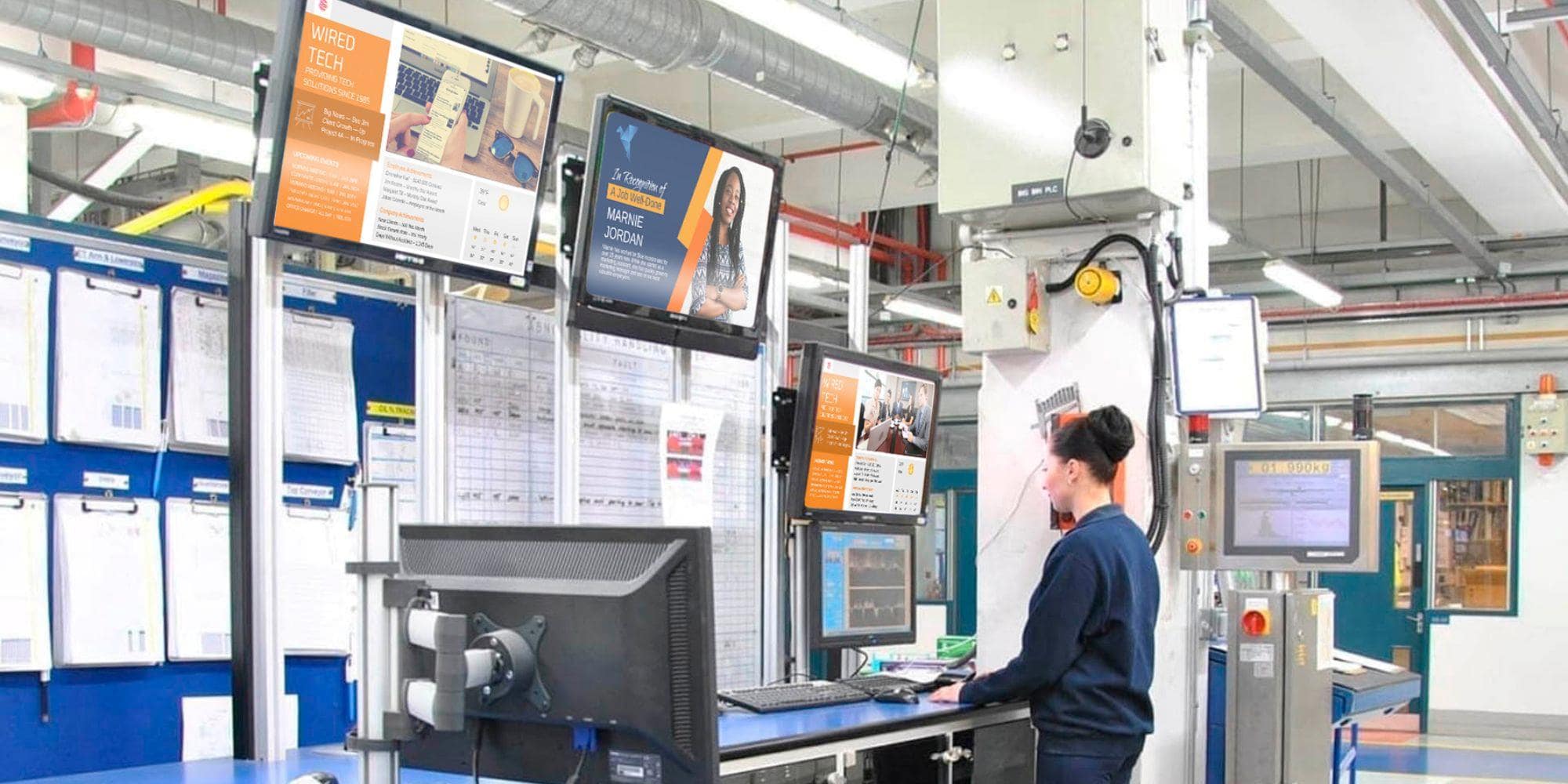
20 Key Features for Enterprise Digital Signage
Enterprise digital signage solutions encompasses a range of features that significantly influence the effectiveness and efficiency of digital communication strategies. These attributes, from seamless content synchronization to advanced analytics, are evolving rapidly to meet modern business demands. Understanding these 20 key features is crucial for organizations aiming to enhance brand presence, engage customers, and increase ROI.
What Is Enterprise Digital Signage Software?
What sets enterprise digital signage software apart from conventional advertising tools is that this digital signage software offers organizations a dynamic platform to engage with audiences through visually engaging content displayed on digital screens. A study by Signagelive revealed that 71% of businesses reported a significant increase in sales after implementing digital signage.
Thus, despite the implementation challenges, such as integrating the software with existing systems, the profitability of reducing printing costs and increasing ROI makes it a worthwhile investment.
Customization options allow businesses to tailor content based on location, time of day, or target audience, improving the overall user experience. User training is essential to get the most out of the software and ensure smooth operation.
Security issues, such as protecting sensitive information displayed on screens, highlight the importance of implementing robust security measures in software.
20 Crucial Features of an Enterprise Digital Signage Software
When considering enterprise digital signage software, key features like scalability, centralized management, content management system (CMS), multi-zone layouts, and integration capabilities are crucial in ensuring an effective and efficient system.
These features are fundamental for managing an extensive network of displays across multiple locations, providing flexibility in content creation and distribution, and integrating with other systems within the organization.
Understanding and utilizing these features allows businesses to enhance communication, engagement, and overall performance through their digital signage solutions.

Scalability
Scalability is vital in determining the effectiveness and adaptability of an enterprise digital signage software solution. Conducting a cost analysis ensures that the software can grow with the business without incurring significant additional expenses.
Implementation challenges may arise if the software is not designed to scale seamlessly, impacting the user experience and overall efficiency.
Addressing scalability from the outset allows businesses to future-proof their digital signage setup, allowing for smooth growth and adaptability to changing needs.
Centralized Management
Efficient management of digital signage content and networks is crucial for successful enterprise deployment, with centralized management playing a key role in streamlining operations and maximizing impact. Remote access allows administrators to control screens from anywhere, ensuring real-time updates and troubleshooting.
Network security features safeguard sensitive information and prevent unauthorized access or tampering. System integration capabilities enable seamless connectivity with existing software and hardware, ensuring a cohesive digital ecosystem.
Data analytics tools provide valuable insights into content performance and audience engagement, allowing for data-driven decision-making. A user-friendly interface simplifies content scheduling, layout design, and monitoring, enhancing overall usability and productivity in managing digital signage networks.
Content Management System (CMS)
A robust content management system (CMS) is essential for orchestrating and delivering dynamic content across enterprise digital signage networks. Content customization allows for tailored messaging to different audience segments, ensuring relevance and engagement. User permissions ensure that only authorized personnel can access and modify content, maintaining security and consistency.
Template options streamline content creation by providing pre-designed layouts for quick and easy updates. Scheduling flexibility enables content to be displayed at specific times or dates, optimizing communication strategies.
Interactive features like touch-screen capabilities or real-time data integration enhance audience engagement and provide valuable insights.
Multi-zone Layouts
An essential feature of top-tier enterprise digital signage software is the incorporation of multi-zone layouts, enabling dynamic and targeted content placement for enhanced engagement and communication effectiveness. Design flexibility and creative freedom are key aspects of multi-zone layouts, allowing users to customize content zoning and layout options to suit their specific needs.
By establishing a clear visual hierarchy and prioritizing information effectively, businesses can capture audience attention and convey messages with impact. Interactive experiences drive user engagement, fostering a more immersive viewing environment. Furthermore, the integration of multi-zone layouts ensures brand consistency across all digital signage displays, reinforcing the organization's identity and message delivery.
Integration Capabilities
Integration solutions are crucial in ensuring seamless connectivity within the digital signage ecosystem. API integration enables software integration, allowing smooth data and content exchange across various systems. Meanwhile, data integration is essential for ensuring that the right information is displayed at the right time, enhancing the overall impact of digital signage.
User Access Control
When considering user access control, the following key aspects are vital:
- User Authentication: Implementing secure login processes to verify the identity of users.
- Access Levels: Assigning specific levels of access based on user roles and responsibilities.
- Permission Management: Allowing administrators to control and customize user permissions for different functionalities.
Remote Monitoring and Diagnostics
Remote troubleshooting is necessary for promptly addressing any issues that may arise, ensuring minimal disruptions to operations. Diagnostic tools help to identify and resolve technical problems efficiently. Performance monitoring allows businesses to track the effectiveness of their digital signage campaigns and make data-driven decisions.
System alerts provide real-time notifications for potential issues, enabling proactive management, while maintenance scheduling helps organizations plan and execute regular upkeep tasks, preventing downtime.

Interactive Touchscreen Support
Interactive touchscreen support is a fundamental element in modern enterprise digital signage software, facilitating enhanced user engagement and interactivity. Research by Nielsen found that interactive digital signage can increase engagement by up to 60% compared to static displays.
When considering this feature, consider the following key aspects:
- Touchscreen interactivity enables users to interact directly with the content displayed, creating a more engaging experience.
- User engagement enhances user experience by allowing individuals to actively participate with the information presented.
- Interactive displays transform traditional signage into dynamic platforms that invite interaction and exploration.
Incorporating these elements into Enterprise Digital Signage software upgrades touchscreen functionality, enabling increased customer interaction and promoting a more immersive experience.
Mobile Device Integration
Mobile devices are crucial in today's fast-changing tech environment. Using devices, apps, and location targeting is vital for smoothly integrating with digital signage, ensuring a personalized experience. This boosts user engagement and guarantees an effective communication strategy in the ever-evolving digital world. Leveraging the power of mobile technology enables businesses to stay ahead in the competitive landscape and deliver tailored content that connects with their audience.
Real-time Data Integration
Real-time data integration enhances Enterprise Digital Signage by delivering dynamic and current content. It offers immediate insights through live metrics and screen trends, aiding quick decision-making. Integration with IoT devices allows the inclusion of sensor data, creating interactive and personalized content.
Cloud storage ensures secure data access, maintaining the integrity of displayed information. This real-time approach keeps content fresh and maximizes the software's impact in a dynamic business environment.
Content Scheduling and Automation
Content Scheduling and Automation features allow businesses to efficiently tailor messages to specific audiences through customization and automation. Scheduling tools ensure timely content display, boosting targeted messaging and audience engagement. Automation offers benefits like reducing manual efforts, maintaining messaging consistency, and facilitating personalized content delivery. Overall, these features significantly enhance the effectiveness of digital signage in the corporate environment, making communication more strategic and impactful.
Emergency Alerts and Notifications
In Enterprise Digital Signage, Emergency Alerts and Notifications aid in swift communication during urgent corporate situations. Best practices include automated emergency response strategies for quick activation, ensuring effective notification systems through regular testing and updates, and establishing alert management protocols for the timely dissemination of critical information. These features are crucial for maintaining a safe and informed environment within an enterprise setting.
Utilizing various communication channels during emergencies enhances overall preparedness and response capabilities, ensuring the safety of both the organization and its personnel.
Audience Analytics and Reporting
By utilizing straightforward data analysis tools, businesses can optimize engagement and assess communication strategies.
Performance metrics enable campaign optimization, ensuring content resonates with the audience. Data visualization allows businesses to track ROI and better understand audience engagement. These insights enhance digital signage effectiveness and provide valuable information for future content strategies. Simplifying analytics and reporting is key to tailoring communication and ensuring impactful interactions with the audience.

Content Personalization
Optimizing content personalization is a great feature that distinguishes top-tier Enterprise Digital Signage software, allowing businesses to tailor messages and visuals to specific audiences with precision and impact. When considering content personalization, key elements include:
- Personalized Content Customization: Tailoring content to individual preferences enhances engagement and relevance.
- Targeted Messaging and Audience Segmentation: Delivering messages to specific demographics or groups increases the effectiveness of communication.
- Dynamic Displays and Tailored Information: Providing real-time updates and custom information ensures that content remains fresh and engaging.
Multi-language Support
Enterprise Digital Signage software offers localization options, tailoring content to specific regions and demographics for effective global communication. Cultural adaptation ensures messages resonate across diverse backgrounds, fostering better understanding.
Language customization features empower businesses to convey accurate messages in various languages, enhancing international reach. With multi-language support, companies break language barriers, delivering engaging content that directly connects with the audience. This approach strengthens connections and maximizes the impact of digital signage strategies on a broader scale.
Content Templates and Widgets
Content templates and widgets serve as foundational tools for creating dynamic and visually engaging displays tailored to specific communication needs. When considering these features, here are three key aspects to keep in mind:
- Design Customization: Templates allow for easy customization of layouts, fonts, colors, and branding elements to align with corporate identity.
- Interactive Engagement: Widgets enable interactive content such as surveys, videos, or live social media feeds, enhancing viewer engagement.
- Data Analytics: Track performance metrics like viewer engagement, content popularity, and dwell time to optimize messaging effectiveness.
These tools also facilitate social media integration and real-time updates, ensuring the audience is presented with relevant and up-to-date information.
Brand Consistency Tools
According to a study by Intel, digital signage can increase brand awareness by 47.7%, with 75% of customers saying they have told others about a business because of its signage. Enterprise Digital Signage helps businesses maintain a consistent visual representation of the brand, incorporating specific design elements, colors, fonts, and logos that align with the organization's marketing strategy.
By enforcing brand consistency, businesses can enhance customer engagement and recognition, ultimately strengthening brand loyalty. The ability to customize templates and widgets with brand-specific guidelines ensures that every piece of content displayed reflects the brand's identity accurately.
Compliance and Accessibility Features
In attaining conformity with industry benchmarks and augmenting accessibility for all users, the software should contain:
- Compliance Management: Features that seamlessly align with industry regulations.
- Accessibility Standards: Design to accommodate users with disabilities, following guidelines for inclusive content.
- Regulatory Requirements: Stay updated with legal obligations by integrating features that effectively meet standards.
This ensures a professional and compliant approach, catering to diverse user needs and staying in line with industry regulations.
Energy-saving Features
Prioritizing sustainability and efficiency, energy-saving functionalities are integral to optimizing the operational efficiency of enterprise digital signage software.
Integrating tips for energy efficiency and sustainable practices not only trims operational expenses but also aligns with eco-friendly technology solutions. The software substantially reduces energy consumption by incorporating power-saving strategies, fostering environmental responsibility. Opting for eco-friendly signage contributes to a greener ethos and ensures long-term cost savings.
These features underscore a commitment to sustainability and emphasize a company's dedication to minimizing its carbon footprint by adopting energy-efficient technologies in digital signage solutions.
Remote Software Updates
Seamless integration of remote software updates ensures the prompt deployment of content and software enhancements across all signage devices. Maximizing efficiency involves quick remote troubleshooting, enabling swift identification and resolution of software issues without physical intervention.
Prioritizing software compatibility ensures updates align with existing hardware and software configurations, minimizing disruptions. Additionally, stringent implementation of robust network security measures safeguards against potential cyber threats and unauthorized access.
This streamlined approach enhances digital signage solutions' overall effectiveness and reliability in corporate environments.
Content Synchronization
In corporate digital signage, seamless content synchronization is undoubtedly important. Effective content distribution ensures timely delivery to screens, optimizing communication. Media Sync harmonizes video, images, and text for a visually appealing experience. Controlling multiple screens to coordinate displays showcases complementary content, promoting interaction. The exchange of information between displays unifies the message, consistently reaching the audience. Regardless of their location in the enterprise, this approach reinforces the brand identity and provides a consistent narrative. Achieving message consistency is key to a compelling and unified communications strategy that enhances the impact of digital signage in corporate settings.
Key Takeaways
To understand enterprise digital signage, focus on these crucial takeaways that make communication successful in this dynamic field:
- Implementation strategies: Developing a clear roadmap and timeline for deploying free digital signage solutions is paramount for success.
- Best practices: Adhering to industry standards and leveraging proven techniques can enhance the effectiveness of digital signage campaigns.
- ROI analysis: Conducting regular assessments to measure the return on investment and adjusting strategies accordingly can ensure long-term success in digital signage initiatives.
More From Our Blog
-

How to Use PowerPoint for Digital Signage
To create stunning, attention-grabbing, and effective digital signage content, you need the help of content creation and presentation tools. One of the most popular is Microsoft PowerPoint, owing to[…]
Read More -

120 Digital Signage Content Ideas
So…. you decided you would invest in some digital signage software and you need some ideas for ways you can make it stand out. This article is your go-to source for the best digital signage content[…]
Read More -

2025 Digital Signage Benefits and Statistics
The digital signage industry has been growing steadily for years now, and it shows no signs of stopping anytime soon. Businesses all over the world are investing in digital signage systems, be it for[…]
Read More
Keep Your Displays Interesting – Pick New Templates Every Week!
Every week, we send template recommendations that will make you look great and improve your audience experience. And the best part, they save up to 16 hours of content creation time every week!
12,300+ Organizations Trust Rise Vision, You Can Too
Schedule a Free Demo
You deserve the #1 all-in-one platform for digital signage, screen sharing, and emergency alerts.



































